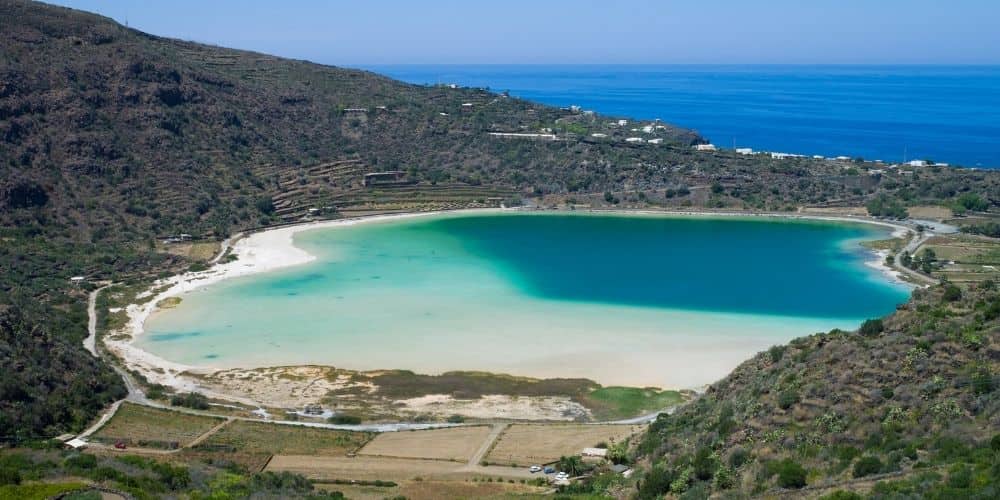But let's find out together which are the unmissable places of Pantelleria.

Pantelleria Castle

The Castle of Pantelleria is one of the most important architectural artefacts of the island; it is a real medieval symbol and monument of the city. Made of lava stone (the most common stone in the island), it overlooks the island from a high promontory which gives it excellent visibility even from the sea. Until 1975 it was used as a prison but since 2015 it has housed the most important archaeological discoveries in the Pantelleria area.
The castle is also known as Castello Barbacane, due to a transcription error, and was built by the Spaniards to fortify the area from continuous enemy attacks. The castle is made up of two parts, one accessible and the other more private. The entrance to the castle is preceded by a large monumental staircase. The predominant material in the building is Pantelleria lava stone held together and often decorated through the use of lime.
Arco dell'elefante

The Arco dell’Elefante is one of the most evocative places on the island. It can be easily reached by car and welcomes thousands of tourists every year. Its history is very simple as if seen from afar its morphology recalls the face of an elephant with its trunk in the water. It creates a wonderful natural arch, probably formed by a powerful volcanic eruption that threw lava material into the water, which solidifying gave the island this beautiful scenery. This spectacular tunnel is one of the symbols of Pantelleria.
Pantelleria Lake

The lake of Bagno dell'Acqua or the lake of Venus is a masterpiece of nature located in the area of the Bugeber district. The lake owes its conformation to the various volcanic phenomena that have led to its current form and which have given a very particular ecosystem extremely different from the Mediterranean scrub.
Located, more or less, in the centre of the island, the lake also owes its fame to other factors. The first is the mythological tale, it is said that the beautiful Aphrodite was reflected in this lake before meeting Dionysus. Another point of particular interest is that the ecosystem offers such biodiversity that the organisms found within it could date back to the Proterozoic Aeon period (about two and a half billion years ago) when multicellular organisms had not yet appeared. The factor that probably makes the lake more attractive are the sources of natural thermal water. A spectacle of nature that offers hot water baths up to 50 degrees. Tourists usually cover their skin with these muds which can have very beneficial effects.
Finally, the peculiarity of the ecosystem, also, offers the visit of different species of birds. In the migratory phase, they decide to settle for a period along the coasts of this lake.
The dammusi

The Pantelleria dammusi are one of the typical buildings of the island of Pantelleria. Their peculiarity lies in the use of lava stone, squared and badly cut, which makes up the wall perimeter and which supports a domed ceiling, often white. Outside the inhabited centre, it is the only type of housing you can come across and they are one of the ways to immerse yourself fully in the life of the island. Many tourists rent a dammuso to spend their holidays in Pantelleria.
These structures are of Arab influence and are born as a rural element. They are built on the natural characteristics of the island such as wind, heat, scarcity of rain, etc. The domed roofs are used to collect rainwater in the cisterns and deflect the wind; the thickness of the perimeter wall (up to one meter and forty) guarantees thermal insulation from both cold and heat, together with the very small doors and windows located along the walls. The exterior of the dammuso is often characterized by large spaces where you can relax and you can almost always find a jardinu, a circular construction in lava stone that shelters the fruit crops from the strong wind.
The sapling vine

The cultivation of the sapling vine is called heroic agriculture because it contrasts with the aforementioned adverse environmental conditions. Over the years, the Pantelleria tradition has been able to adapt to these adversities, so much so that it has created real agricultural practices of inestimable value. The sapling vine is grown in small pits that collect the scarce rainwater that falls and, as in the case of the Pantelleria garden fence, protect the plant from the strong wind. This cultivation technique dates back to the Phoenicians and is still used today to create the famous and precious Passito di Pantelleria.
Since 2014, UNESCO has recognized the importance of this agricultural practice of the sapling vine, inscribing it on the List of Intangible Heritage of Humanity.
National Park of Pantelleria island

It is very difficult to try to concentrate in a few points all the beauties that characterize the island of Pantelleria, but most of them are gathered in one of the most beautiful places on the island and in Italy: the National Park of the Island of Pantelleria. This beautiful protected natural area is the last of the national parks founded in Italy (2016) but it collects a varied amalgam of biodiversity, history and culture that make it a beautiful place to visit in every corner. Its extension covers almost the whole island and collects the most beautiful natural and artificial attractions of the whole island.
Inside you can find archaeological areas, religious and civil architecture, but also all the flora and fauna of these places, as well as all the natural caves that the island enjoys.
NATIONAL PARK OF PANTELLERIA
Nature and prehistoric populations, accompanied by Greek, Roman, Arab, Spanish period have left evident traces on the current Pantelleria and it would be a shame not to visit them. So what are you waiting for? Come to Pantelleria to experience the beauty of one of the most beautiful smaller islands in Italy.
About the author
Written on 31/05/2021



Mario Galterisi
Pantelleria is the smaller island of the largest of Sicily. It is much closer to Africa than to Sicily and this has given the island a remarkable versatility.